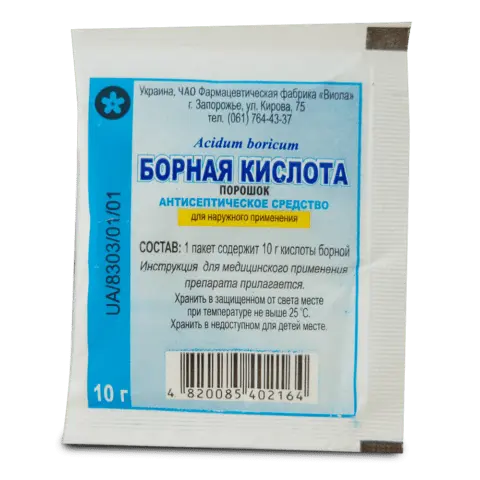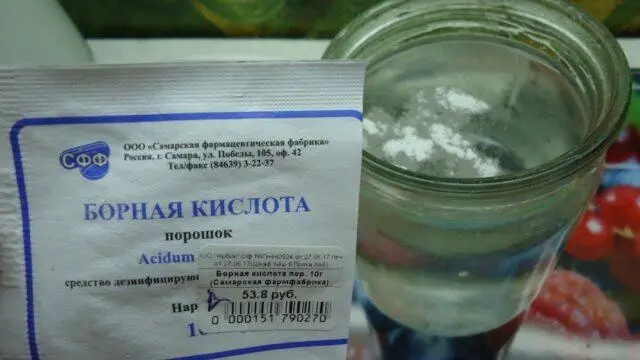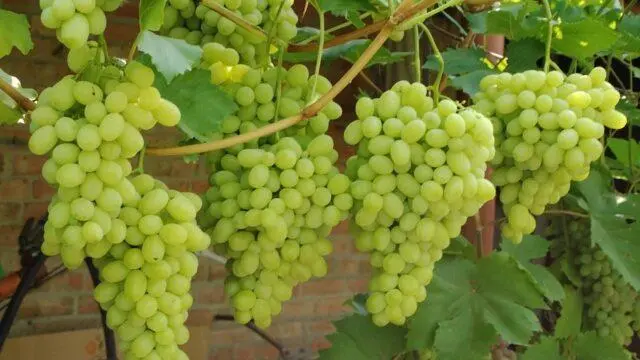Contents
Boric acid for grapes is necessary to stimulate the growth of ovaries, attract pollinators, as well as to treat and prevent certain fungal diseases. Processing is carried out several times per season. Not only the acid powder itself is added to the solution, but also other useful components, both mineral and organic, for example, potassium humate or Kemira Lux.
Why treat grapes with boric acid
Boron is one of the most important trace elements necessary for all plants, especially at the stage of flowering and fruiting. It is he who ensures the normal laying of flowers and ovaries, the formation of buds, as well as the growth of fruits. Therefore, the lack of boron or its complete absence negatively affects the yield.
Grapes should be treated with boric acid for several purposes:
- An increase in green mass due to the active synthesis of nitrogenous compounds, which are affected by boron.
- Preventing the death of a young grape seedling.
- Increase resistance to adverse weather conditions.
- It is also possible to treat grapes with boric acid to increase the ovaries.
- Increased pollination, which also affects the yield (an increase of up to 25% is noted).
- Improvement of taste quality, sugar content, aroma of berries, as well as their size.
- An increase in the keeping quality of fruits due to the fact that the berries crack less even with excessive moisture.
- Boric acid is involved in the prevention of fungal infections, including phomosis, and also effectively prevents the appearance of pests (aphids, ants, and others).

Boric acid is the main source of boron for grapes.
Boron deficiency or excess symptoms
Deficiency of this element in grapes is observed quite often. You can determine the lack of boron by the following signs:
- the leaves are bent, shaped like a dome;
- the surface of the foliage has a mosaic color;
- the top of the grape vine dies around mid-July;
- flowering is poor, the set is insignificant;
- grape shoots are too close to each other;
- branches develop at a slow pace;
- pea berries (a large number of small fruits with a pea);
- the pulp becomes brown;
- brown thickenings on the antennae;
- if you dig a bush, you can see that the rhizomes rot.
Each element must enter the plant tissue in the optimal amount. Practice shows that an excess of a substance is no less destructive than its deficiency. Therefore, it is important to learn how to determine the excess of the boron norm. The main signs are as follows:
- the leaves do not acquire a dome-shaped, but, on the contrary, a cup-shaped shape;
- small brown spots appear on the old lower leaf plates. Gradually, they increase and lead to death.
How to prepare a solution
When preparing a solution of boric acid for grapes, it is important to observe the proportions. The classic version is a composition with a concentration of 0,25%. It’s easy to prepare. You need to act like this:
- Take 2,5 g of boric acid powder. Usually pharmacies sell sachets of 10 g, so you can visually outline a quarter or take a measurement on a scale.
- Pour one glass of hot, but not boiling water. You can pour liquid at room temperature, but then it will be more difficult to dissolve boric acid for grapes.
- Stir well.
- Bring the total volume to 1 liter (you can take water of any temperature).
- If necessary, allow to cool slightly, pour into a spray bottle and proceed to processing the grapes.
To prepare a solution with a volume of 10 liters (standard bucket), take 25 g of boric acid, i.e. 2,5 sachets of 10 g each. This roughly corresponds to a tablespoon with a small slide.

For processing, it is necessary to prepare a solution with a concentration of 0,25%
The use of boric acid for grapes
Boric acid is used for various purposes, for example, for good set or prophylaxis. The amount of the product, the composition of the top dressing (it is possible to use it with other fertilizers) and the processing time depend on this.
To increase the ovaries
Very often, gardeners spray grapes with boric acid to increase the ovaries. This is an effective measure that helps not only to maintain the yield at a normal level, but also to increase the rate. For a guaranteed result, processing is carried out in three stages:
- One week before flowering.
- During the period when the maximum number of inflorescences will bloom.
- At the stage of formation of ovaries.
To improve pollination
Pollination is carried out by insects, which can be attracted by sucrose, i.e. regular sugar. To do this, it is necessary to prepare a sufficiently concentrated solution with a strength of 10%, i.e. add 100 g of sugar per 1 liter or 1 kg of sugar per 10 liters of water. The proportions of boric acid for processing grapes do not change – the concentration is 0,25%. Processing is carried out at all stages of flowering, and you can start already with the blooming of the first buds.
For the prevention of diseases
The acid plays the role of a fungicide, so it can be used to prevent fungal infections. Usually the procedure is carried out in the spring before flowering, i.e. from April to May. The solution can also be used to treat bushes in the initial stages of mildew (downy mildew), oidium and other pathologies. To do the correct processing, you need to act in this way:
- Dissolve 1 tablespoon of acid powder in 1 liter of hot water.
- Mix thoroughly and pour into a bucket of 10 liters.
- Add a few grains of potassium permanganate. As a result, the water should become a light pink, not very saturated color.
- Then add 40 drops of an alcoholic solution of iodine (you can also buy at a pharmacy) to the same volume.
- Mix again. Allow to cool if necessary.
- Pour into a spray bottle and start processing.

Spraying with boric acid allows you to harvest a good harvest in different regions
Treatment of grapes with boric acid before and during flowering
Treatments before flowering and after flowering are especially important as they affect yield. To make the procedure as effective as possible, it is recommended to add not only acid powder, but also other components to the solution. There are three composition options for this.
In the first case, the working solution is prepared from the following components (per 10 liters):
- boric acid – 20 g;
- sugar – 60 g;
- urea – 25 g;
- potassium humate – 40 ml;
- fertilizer “Kemira Lux” – 20 g;
- citric acid – 30 g;
- iron vitriol – 10 g;
- stimulant “Novosil” – 60 drops.
The second composition for processing grapes is represented by the following components (per 10 l):
- boric acid – 10 g;
- citric acid – 10 g;
- urea – 35 g;
- iron sulfate – 15 g.
There is a third option (for 10 liters):
- boric acid – 10 g;
- potassium sulfate – 60 g;
- ammonium sulfate – 90 g;
- zinc sulfate – 10 g;
- cobalt sulfate – 0,5 g;
- manganese sulfate – 15 g;
- superphosphate – 150 g;
- ammonium molybdate – 7 g.
How to treat grapes with boric acid during ripening
At the ripening stage, spraying grapes with boric acid is also carried out using complex formulations. The first cooking option (per 10 l):
- boric acid – 20 g;
- pharmacy alcohol iodine – 3,5 g;
- fertilizer “Kemira Lux” – 20 g;
- fertilizer “Thiovit Jet” – 20 g;
- potassium humate – 60 ml;
- sugar – 60 g;
- stimulant “Novosil” – 90 drops;
- baking soda – 75 g.
The second composition (per 10 l):
- boric acid – 10 g;
- zinc sulfate – 15 g;
- magnesium sulfate – 15 g;
- iron vitriol – 5 g;
- ammonium molybdate – 15 g.

During ripening, it is enough to carry out one spraying with a nutrient
Common mistakes
Pollination of grapes with boric acid is not so difficult if you follow the proportions, timing and other rules. But in practice, beginners and even experienced gardeners often make mistakes that can adversely affect the development of the plant. The most common inaccuracies are:
- You should not think that the more boron, the better. If the leaves of the plant begin to curl inward, dry out, and peculiar burns appear on the surface, then top dressing with the use of acid should be stopped immediately.
- During spraying, droplets should have a minimum size. The atomizer should be set to fine mode.
- Spraying is carried out evenly according to a single pattern so as not to get confused (for example, move only from top to bottom). It is necessary to cover all the leaves so that there are no missing places.
- Along with foliar top dressing, boron can also be given in the traditional way – by watering under the root. In this case, borax is used – the sodium salt of boric acid (sodium tetraborate). To prepare the solution, take 10 g of powder and dissolve in 10 liters of water. Accordingly, the amount of boric acid during foliar treatment should be reduced.
- You can treat grapes with boric acid in a greenhouse with the same compounds. If the shelter is sufficiently reliable, it is possible to work even during rainy, windy weather. If spraying is carried out in the heat, it is better to do it in the evening. Moreover, the greenhouse must be often ventilated by opening the door and vents.
Conclusion
Boric acid for grapes is of great importance. If the element is not enough, this will inevitably affect the yield, the development of the bush, and reduce its resistance to fungal diseases. Therefore, spraying using a powder solution should be carried out regularly. The remedy should not be abused either – it is necessary to observe the described proportions.









